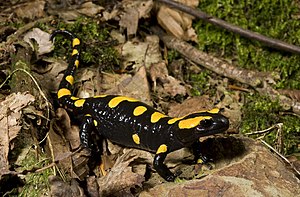South Spanish fire salamander
| South Spanish fire salamander | ||||||||||||
|---|---|---|---|---|---|---|---|---|---|---|---|---|

Southern Spanish fire salamander ( Salamandra longirostris ) |
||||||||||||
| Systematics | ||||||||||||
|
||||||||||||
| Scientific name | ||||||||||||
| Salamandra longirostris | ||||||||||||
| Joger & Steinfartz , 1994 |
The southern Spain salamander ( Salamandra longirostris ) is an amphibian species from the order of Caudates (caudata). Formerly the taxon was treated as a subspecies of the fire salamander ( Salamandra salamandra ); some authors continue to do so.
features
The southern Spanish fire salamander is a large salamander with a total length of on average 18 to 19, maximum up to a good 22 centimeters. The basic color is black. There are large, lemon-yellow spots on the top, these do not contain any red. The top of the head has six large, yellow spots. Two are above the eyes, two on the large parotid (glandular bulges) and one on each side of the head between the corner of the mouth and the back of the eyes. Characteristic features are the lack of red and the pointed snout. In the side view, this protrudes beyond the crack in the mouth.
The larvae correspond to those of the fire salamander ( Salamandra salamandra ).
Occurrence
The distribution area of the southern Spanish fire salamander includes the Sierra de Ronda in southern Andalusia (southern Spain). In addition, there is a deposit near the port city of Marbella , which is believed to be isolated from the rest of the area. The species occurs from just above sea level to at least 820 meters above sea level (near Grazalema , Sierra de Ronda). The Sierra de Ronda is only sparsely forested with holm oaks ( Quercus ilex ) and hedgehog firs ( Abies pinsapo ). The salamanders have hiding places in the crevices and cave systems of the karstified limestone. The larvae develop in still and flowing waters, for example wells, ponds, streams and puddles.
Way of life
Little is known about the way of life. The main activity time is in the humid winter months, in summer the animals hide deep in the ground.
etymology
The specific epithet longirostris is derived from the Latin longus (= long) and rostrum (= snout) and refers to the snout, which protrudes clearly and is pointed.
supporting documents
- Dieter Glandt : Pocket dictionary of amphibians and reptiles in Europe. All types from the Canary Islands to the Urals. Quelle & Meyer, Wiebelsheim 2010, ISBN 978-3-494-01470-8 .